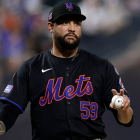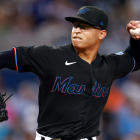
The Texas Rangers pulled off the most shocking trade of the deadline on Saturday evening, acquiring right-hander Max Scherzer and significant cash considerations from the New York Mets in exchange for infield prospect Luisangel Acuña. (You can read more about the trade here.) As part of the agreement, Scherzer has reportedly exercised his option for next season that will see him earn more than $43 million. (The Rangers will be responsible for only $22.5 million of Scherzer's overall take-home amount, per multiple reports.)
Scherzer, a three-time Cy Young Award, will join arguably the most surprising team in the majors. The Rangers didn't just enter Saturday in first place in the American League West, they came into play with the best run differential in the league. That's no small feat given how well the Baltimore Orioles and Tampa Bay Rays have played so far this year, not to mention the Houston Astros.
Trades of this magnitude tend to have numerous ramifications for the organizations that make them. Let's break down three of those as it pertains to the Scherzer deal and what it means for the Rangers.
1. Improves playoff rotation
The Rangers added one former Mets ace to their rotation over the winter, when they signed Jacob deGrom to a lucrative free-agent contract. Unfortunately, deGrom is out for the season after undergoing Tommy John surgery in June. The Rangers have nevertheless managed the fifth-lowest rotational ERA in the majors thanks to brilliance from Nathan Eovaldi, Jon Gray, and Dane Dunning.
Scherzer hasn't been his usual self this season. In addition to serving a 10-game suspension after violating MLB's grip-enhancing substance policy, he's sporting his lowest ERA+ (103) since 2011. That doesn't mean he won't provide an upgrade over some of the Rangers' lesser starting options.
Take a look at how Scherzer's year stacks up to the rest of Texas' arms:
| Pitcher | GS | IP | ERA+ | SO/BB |
|---|---|---|---|---|
Max Scherzer (NYM) | 19 | 107.2 | 103 | 4.03 |
Nathan Eovaldi | 19 | 123.2 | 162 | 3.26 |
Jon Gray | 19 | 108.1 | 119 | 2.41 |
Dane Dunning | 15 | 107 | 133 | 2.27 |
Martín Pérez | 19 | 102.2 | 89 | 1.79 |
20 | 101.1 | 94 | 2.40 |
Depending on how those individuals pitch the rest of the way, the Rangers could theoretically field a playoff rotation where Scherzer has the lowest ERA+. That's a fancy way of saying that Texas' rotation, long a mess, has become a strength for this version of the team thanks to a series of veteran additions.
2. Held onto top prospects
We're fans of the younger Acuña. He'll be a top-50 candidate this offseason, when we go about doing new versions of the prospect lists. But, for as exciting and intriguing as he is, it's fair to write he's no Evan Carter.
Carter, a 20-year-old outfielder, was recently named by CBS Sports as the ninth-best prospect in all the minors. In 71 Double-A games this season, he's batted .292/.407/.463 with 11 home runs, 50 RBI, and 11 stolen bases. He could well make his big-league debut later this year, or perhaps early next.
Second home run in three games for Evan Carter!
— MLB Pipeline (@MLBPipeline) July 21, 2023
The top @Rangers prospect clubs his 10th long ball for @RidersBaseball: pic.twitter.com/O9Ao7l1AvY
Additionally, the Rangers also kept teenage shortstop Sebastian Walcott, whose first season in the complex league has raised eyebrows thanks to his well-above-average power potential and chances of sticking on the left side of the infield. Walcott will likely shoot up prospect lists this winter as well.
In a vacuum, the Rangers likely would've preferred to keep Carter and Walcott over Acuña. With context, it makes even more sense. Acuña isn't that far off from The Show, yet the Rangers have an ample amount of talented infielders, including well-compensated veterans Corey Seager and Marcus Semien in addition to intriguing, productive youngsters Josh Jung and Ezequiel Durán.
If the Rangers had to trade one of the three aforementioned players, Acuña was the most expendable. That's no knock on him by any means, but it does make losing him sting less if you're the Rangers.
3. Protected financially
For as good as Scherzer has been throughout his career, it's fair to write that there would've been downside risk in paying him more than $43 million for his age-39 season -- especially given that he's had a down season so far in 2023. Convincing the Mets to foot so much of the bill (which billionaire owner Steve Cohen was likely more than happy to do) not only serves as an insurance policy, but also minimizes the opportunity cost of the transaction.
The money is messy, but the Rangers are on the hook for less than $23 million in total for Scherzer. Even if that's entirely to be paid next season, that $20 million difference is significant. To wit, the Rangers will be paying more than that to deGrom, Seager, and Semien next season, according to Cot's Contracts.
That money could come in handy this winter, when a number of veterans hit free agency, including the aforementioned Pérez, Aroldis Chapman, Will Smith, Brad Miller, Mitch Garver, and others. The Rangers will also see Adolis García, Jonah Heim, Dunning, and Brock Burke earn arbitration raises:


















